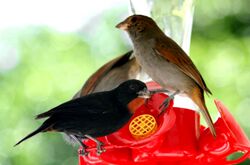Biology:Lesser Antillean bullfinch
| Lesser Antillean bullfinch | |
|---|---|

| |
| Male and two females in Dominica | |
| Scientific classification | |
| Domain: | Eukaryota |
| Kingdom: | Animalia |
| Phylum: | Chordata |
| Class: | Aves |
| Order: | Passeriformes |
| Family: | Thraupidae |
| Genus: | Loxigilla |
| Species: | L. noctis
|
| Binomial name | |
| Loxigilla noctis (Linnaeus, 1766)
| |

| |
| Synonyms | |
|
Fringilla noctis (protonym) | |
The lesser Antillean bullfinch (Loxigilla noctis) is a species of bird in the family Thraupidae. It is found in Saint Barth, Saint Martin, Anguilla, Antigua and Barbuda, Dominica, Grenada, Guadeloupe, Martinique, Montserrat, Netherlands Antilles, Saint Kitts and Nevis, Saint Lucia, Saint Vincent and the Grenadines, the British Virgin Islands, and the U.S. Virgin Islands.
Its natural habitats are subtropical or tropical dry forest, subtropical or tropical moist lowland forest, and heavily degraded former forest.
Taxonomy
The lesser Antillean bullfinch was formally described by the Swedish naturalist Carl Linnaeus in 1766 in the twelfth edition of his Systema Naturae under the binomial name Fringilla noctis.[2] Linnaeus's description was primary based on "Le Père Noir" that French zoologist Mathurin Jacques Brisson had described and illustrated in 1760.[3] The specific epithet noctis is from the Latin nox meaning "night".[4] The Lesser Antillean bullfinch is now placed in the genus Loxigilla that was introduced in 1831 by René Lesson.[5][6]
Eight subspecies are recognised:[6]
- L. n. coryi (Ridgway, 1898) – northwest Lesser Antilles
- L. n. ridgwayi (Cory, 1892) – US Virgin Islands and north Lesser Antilles
- L. n. desiradensis Danforth, 1937 – La Désirade (north-central Lesser Antilles)
- L. n. dominicana (Ridgway, 1898) – north-central Lesser Antilles
- L. n. noctis (Linnaeus, 1766) – Martinique
- L. n. sclateri Allen, JA, 1880 – Saint Lucia
- L. n. crissalis (Ridgway, 1898) – Saint Vincent
- L. n. grenadensis (Cory, 1892) – Grenada
In 2006 the Barbados bullfinch (Loxigilla barbadensis) was elevated to the species level; previously the species had been considered as the only non-sexually dimorphic subspecies of the Lesser Antillean bullfinch.[7][8]
Gallery
References
- ↑ BirdLife International (2018). "Loxigilla noctis". IUCN Red List of Threatened Species 2018: e.T22734677A132183438. doi:10.2305/IUCN.UK.2018-2.RLTS.T22734677A132183438.en. https://www.iucnredlist.org/species/22734677/132183438. Retrieved 12 November 2021.
- ↑ Linnaeus, Carl (1766) (in Latin). Systema naturae : per regna tria natura, secundum classes, ordines, genera, species, cum characteribus, differentiis, synonymis, locis. 1, Part 1 (12th ed.). Holmiae (Stockholm): Laurentii Salvii. pp. 320–321. https://www.biodiversitylibrary.org/page/42946516.
- ↑ Brisson, Mathurin Jacques (1760) (in French, Latin). Ornithologie, ou, Méthode Contenant la Division des Oiseaux en Ordres, Sections, Genres, Especes & leurs Variétés. 3. Paris: Jean-Baptiste Bauche. pp. 118–119, Plate 7 fig. 1. https://www.biodiversitylibrary.org/page/14483394.
- ↑ Jobling, James A. (2010). The Helm Dictionary of Scientific Bird Names. London: Christopher Helm. p. 274. ISBN 978-1-4081-2501-4.
- ↑ Lesson, René (1831) (in French). Traité d'Ornithologie, ou Tableau Méthodique. Paris: F.G. Levrault. p. 443. https://www.biodiversitylibrary.org/page/35997427.
- ↑ 6.0 6.1 Gill, Frank; Donsker, David; Rasmussen, Pamela, eds (July 2020). "Tanagers and allies". IOC World Bird List Version 10.2. International Ornithologists' Union. https://www.worldbirdnames.org/bow/tanagers/.
- ↑ Buckley, P.A.; Buckley, F.G. (2004). "Rapid speciation by a Lesser Antillean endemic, Barbados Bullfinch Loxigilla barbadensis". Bulletin of the British Ornithologists' Club 125: 108–123. https://www.biodiversitylibrary.org/page/40056085.
- ↑ Banks, R.C.; Cicero, C.; Dunn, J.L.; Kratter, A.W.; Rasmussen, P.C.; Remsen, J.V.; Rising, J.D.; Stotz, D.F. (2006). "Forty-Seventh Supplement to the American Ornithologists' Union Check-List of North American Birds". The Auk 123 (3): 926–936. doi:10.1093/auk/123.3.926.
External links
Wikidata ☰ Q1587899 entry
 |






